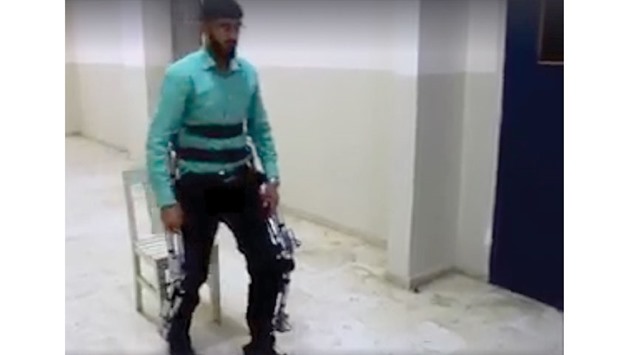
IN ACTION: A screen grab showing mechatronics student Mahmoud Barham as he demonstrates AZR.
As with every competition, Microsoft Imagine Cup 2016 Pan Arab Semi-Finals, too, had to pick its winners – three of them in each of the three categories; Innovation, World Citizenship, and Games.
However, it’s anybody’s guess that such a fine congregation of young bright talents would metaphorically produce dozens of winners, some of who stood out because of the nobility of their innovations – making life easier for the disabled.
Imagine Cup, Microsoft’s premier student technology programme and competition that hosted a record 150 students in 37 teams, representing 13 Arab countries this year, is known to provide opportunities for students across all disciplines to team up and use their creativity, passion and knowledge of technology to create applications, games and integrate solutions that can change the way we live, work and play.
Some of the student innovations indeed promised to change the way the disabled live, such as AZR.
Aiming to primarily aid those injured in the wars in Palestine, three West Bank students have built AZR, a humanoid exoskeleton unit that enables those with lower limb disabilities to leave their wheelchairs and walk, and even climb stairs. The brains behind this ingenious device are mechatronics student Mahmoud Barham, and electrical engineering students Samer Mukheimer and Mustafa Abu Safia.
Soon after presenting it to the jury, Barham tells Community, “In Palestine, we have several instances of disabilities due to injuries caused by wars. There are many old people, including my grandparents, who suffer from lower limb disabilities. According to the Palestinian Central Bureau of Statistics, about 113,000 individuals suffer from at least one disability in Palestine, and that number is only increasing by the day. We decided we must help these people.”
Aimed at making people with disabilities more independent, actions are controlled by multiple sensors. “Some sensors detect knee position, knee angle, and weight on foot. Other sensors measure and analyse muscle contractions. The goal is to coordinate users’ movements, and help them accomplish complex movements, like climbing and descending stairs,” writes Rafat Abushaban in his piece on AZR for the website Wamda.
Barham points out that in Palestine, they don’t have access to improved technologies or materials and also lack funds to develop such concepts. “But we are hardworking engineers who have spent around 15 months working on this project. We work. We don’t give up,” Barham says.
In the pipeline is more research and development to make AZR lighter — currently it weighs 10.5 kg — and also increase its weight-bearing capacity from its current limit of 80 kg. “We have used aluminium, which is light, durable and easy to mould using machines. But we need to fine-tune the design and materials,” Barham says.
While the trio has already tested AZR on people, they don’t have a permit from the Health Ministry to officially test it on patients. “Moreover, a disabled person needs a lot of training to balance his body right and try walking without stumbling and falling down. We are in the process of figuring out the training regimen as well. Also, as disabilities and muscle impulses of each user differ, the device has to be calibrated for every person who is to use it. What’s important for us is that the doctor recommends its use. Fortunately for us, doctors are extremely happy with AZR. They are witnessing something like this for the first time and say that they will help us continue this journey,” Barham says.
Has he only thought of supporting the legs, or also the arms? “First we are working on the lower limbs, but eventually I plan to devise a machine for the upper limbs too. The complete works, you know. Like Iron Man,” he says and smiles.
Just as much of a potential game-changer is Kuwaiti team Robotic Geeks’ EEG-Controlled Smart Prosthetic Arm. Computer engineer Alhamza Abdulmonem and electrical engineer Mohammad al-Qallaf explain: “This project introduces the initial design of a mind-controlled, smart, 3D printed robotic arm. The arm is controlled via brain commands, obtained from an EEG headset. Moreover, it is equipped with a network of sensors to ensure a seamless interaction with the environment. We learned many skills working on this project as it evolves around more than one concentration of engineering and it was a great experience.”
Of course, the device that clinched the top prize in World Citizenship category was Smart Hand, a prosthetic hand for those who have lost one or more of their limbs, by Team Night’s Watch from Tunisia. Combining the forces of a Myo gesture control armband, and a phone app, Smart Hand allows the user to programme his hand using the app – this means the user can grab objects, shake hands and even use a mouse on a PC.
The Imagine Cup 2016 Pan Arab Semi-Finals was held in partnership with The American University in Cairo, School of Business; PepsiCo; Renaissance Hotels; The Ministry of Telecommunication & Information Technology; and EgyptAir. The three winners will head to Seattle to represent the Arab World at the 14th Imagine Cup World Finals in July.
